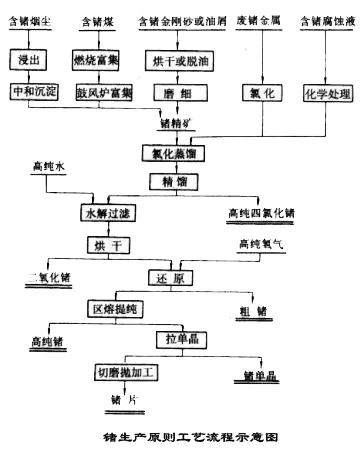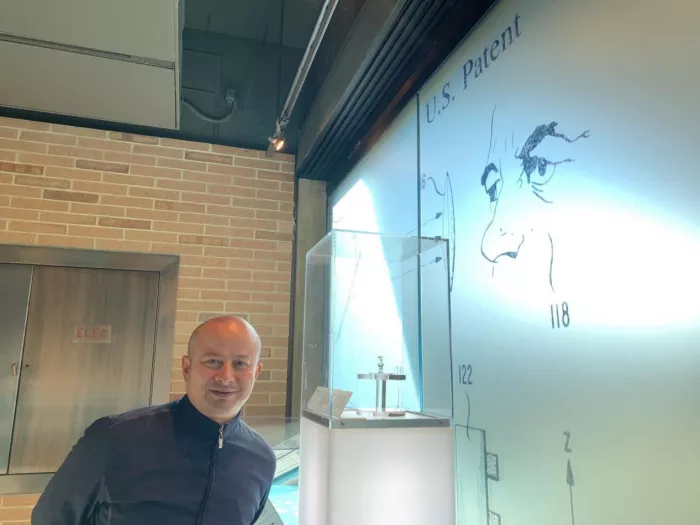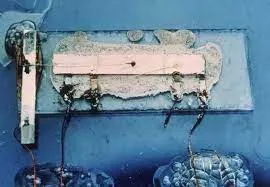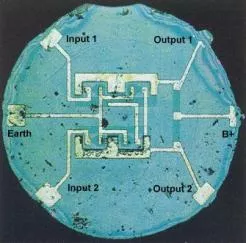Due to high oil prices, new energy vehicles (hybrid and pure electric) have developed faster. The price of the "lithium" element used in power batteries has jumped. The quotation of battery grade lithium carbonate has dropped from less than 50000 yuan / ton at the beginning of 2021 to 520000 yuan / ton in March this year. Recently, it is also between 452000 yuan and 473000 yuan, with an average price of 460000 yuan / ton. In this way, the price has increased nearly 10 times in the past two years.
Because more and more power batteries are used, it is obviously unrealistic to expect a sharp correction in lithium prices. Musk said that we should consider whether to enter the field of mining and refining.

This reminds me of the story of germanium.

A piece of 12g (2 × 3 cm) germanium polycrystal, Encyclopedia
This is the most important element in the transistor era. The biggest benefit people enjoy is semiconductor radio.

In the movie "me and my motherland", in the 1980s, people in Shanghai alley used semiconductor radio to listen to the women's volleyball team win the championship
Germanium was once popular with transistors, and fell apart with the development of integrated circuits (using silicon technology). In recent years, it has returned to everyone's vision with the application of new technologies: the return of Wang "germanium"!
Germanium has good semiconductor properties, such as electron mobility, hole mobility, etc. high purity germanium single crystal has high refractive index, is transparent to infrared, and does not pass through visible light and ultraviolet light. Therefore, it has extensive and important applications in semiconductor, aerospace measurement and control, nuclear physics detection, optical fiber communication, infrared optics and imaging, solar cells, chemical catalysts and other fields.
Three junction GaAs solar cells with long life, high reliability and an average photoelectric conversion efficiency of about 30% have the advantages of high efficiency, high voltage and good high temperature characteristics. They have been used on the Yutu lunar rover, tianwen-1 Mars mission exploration, shenzhou-9 and landsat-1 satellites. Their conversion efficiency is higher than that of crystalline silicon solar photovoltaic cells or single junction GaAs solar cells previously used. Gallium arsenide is more brittle than silicon in physical properties, which makes it easier to crack during processing. Therefore, it is often made into a thin film and a substrate (usually ge[germanium ]) is used to combat its disadvantages in this respect, but it also increases the complexity of the technology.

Tianwen-1 Mars mission probe uses solar cells
In 2020, the global germanium output was 130 tons, ranking first in China. The germanium output in China was 86 tons. For a long time, China's germanium output accounted for more than 60% of the global germanium output. On december31,2020, the spot price of germanium oxide (99.99%) in the London strategic metal market was $950 / kg. As an important rare resource, germanium resources in the world are relatively poor. The proven germanium reserves in the world are about 8600 metal tons. China has a reserve of about 3500 metal tons. There are about 35 proven germanium mineral lands in China, with a prospective reserve of about 9600 metal tons. Germanium is usually associated with lead-zinc ore or exists in lignite, mainly distributed in Inner Mongolia and Yunnan. Large mines include Dazhai germanium mine and meiziqing coal mine owned by Yunnan germanium industry, Yunnan Huize mining area of Chihong Zinc Germanium, Inner Mongolia Shengli Coalfield, etc. The production is mainly concentrated in Yunnan germanium industry, Chihong Zinc Germanium, China germanium technology, Inner Mongolia KONE and other enterprises.
Germanium (germanium) is a chemical element, which was first discovered by German chemist C. A. Winkler (1838 – 1904) at Freiburg Institute of mining in 1886 by means of spectral analysis. The English name germanium comes from the Latin name of Germany.
The element symbol Ge, atomic number 32, atomic weight 72.64, is located in the fourth period and IVA group in the periodic table of chemical elements, and is at the boundary of metal elements and non-metal elements.

"Germanium" is actually a typical semi metal (metalloid) with both metallic and non-metallic properties. Its conductivity is worse than that of general metals and stronger than that of general non-metallic materials.
According to the natural abundance in continental crust, the five stable carbon group elements are silicon (24.4%), carbon (0.2%), lead (12.6 ppm), tin (1.5 ppm), and finally germanium (1.25 ppm). Notice that silicon and germanium are linked together, and both of them stir up the whole electronic world.
The specific gravity of germanium is 5.36, the melting point is 958 ℃, and the boiling point is 2700 ℃. Powdered germanium is dark blue, and crystalline germanium is silver white brittle metal. The chemical properties of germanium are very stable. It is difficult to react with acids and will not be oxidized in the air. However, in the molten state, it is very easy to react with alkali.
Germanium is widely distributed in nature. Copper ore, iron ore, sulfide ore, coal mine, rock, soil and spring water all contain trace germanium. However, germanium is very dispersed, and there is almost no concentrated germanium ore.
It is true that germanium is extracted from soot ash and has been used to this day. German scientist V.W. Goldschmidt, the father of modern geochemistry, first discovered germanium from the analysis of coal ash in 1930.
In the 1950s, the United States built the world's first germanium plant. Germanium is mainly extracted from Zinc Germanium slag in the United States, and germanium is mainly recovered from germanium containing dust in the United Kingdom. The germanium plant built in Belgium in the 1960s is the largest germanium production enterprise in the world, with a monthly production of 6 tons of metal germanium.
At present, the raw materials used by the germanium plant include germanium containing soot produced by coal combustion, germanium concentrate recovered in the smelting process of heavy non-ferrous metals and germanium containing waste produced in the production of semiconductor devices.

China first refined germanium from soot. Germanium is contained in coal. During coal combustion, most germanium compounds are heated and evaporated, and come out together with soot. After entering the flue, the temperature decreases and condenses in the flue ash. According to the determination, the germanium content in flue ash can reach 0.1%, some even as high as 2%, which is 100~2000 times higher than that in coal. Germanium extracted from flue ash or minerals, usually germanium oxide or germanium sulfide. Germanium metal powder can be obtained by reduction with hydrogen, carbon or magnesium, and then heated at 1000 ℃ to form metal germanium ingot. Germanium, which is used to make semiconductors, must be very pure and is usually extracted by "zone melting" metallurgy.
Professor Wujiang of Shanghai Electric Power University said that China has been promoting such research, such as the high value-added application of coal ash and the application of germanium in solar cells.
1、 invention of germanium transistor, becoming the core of electronic technology**
During the Second World War, due to the large demand for radar and radio technology in the military, many British and American research institutions devoted themselves to the research of semiconductor devices. Finding suitable semiconductors and using them to make transistor components is one of the directions explored by solid-state physicists in the early 20th century. Most of the semiconductors known in the early days were metal sulfides or oxides, but in fact, semi-metallic elements (silicon or germanium) were more suitable.
Germanium and silicon have entered people's research field of vision. In the United States, especially K. lark Horovitz's research group at Purdue University has conducted rich and detailed research on the purification of germanium and its device functions.
At the same time, the solid-state physics research group composed of W. Shockley, J. Bardeen and W. H. brattain of Bell Laboratories in the United States tried to manufacture a semiconductor device that can replace electronic tubes. On december15,1947, this kind of experiment yielded fruitful results: they used a blade to draw two extremely thin gaps on the triangular gold foil, then connected wires on both sides, and pressed them into the surface of the germanium block (germanium element provided by lark Horovitz) with a spring. This is a small device composed of germanium, battery, gold wire, spring, cardboard, etc. After connecting the wires, when the two contact points on the germanium block were getting closer and closer, they observed the voltage amplification effect: the 1.3V voltage was amplified by 15 times! The first transistor that changed history was born.

In 2019, Dai Hui, a veteran of science and technology, paid a visit to the first transister of Bell Laboratories

After seeing the huge commercial value of germanium, the industry has developed monocrystalline silicon manufacturing, regional smelting technology for purifying germanium and doping atom technology. With its unique "temperament", from 1947 to 1960, germanium played a core role in the semiconductor component manufacturing industry. Most components were produced with germanium crystal as the core.
Compared with germanium, although silicon has a wider band gap and its electron and hole mobility is not as good as germanium, it is still a semiconductor with good performance. Bell Laboratories also pointed out that the two are expected to replace each other when publishing the triode paper. Silicon purification technology and germanium are also developing at the same time. However, due to the high melting point of silicon dioxide, it was not until the late 1950s that a reliable process was developed to manufacture monocrystalline silicon, which also paved the way for the large-scale utilization of silicon in integrated circuits.
2、 Invention of integrated circuit, silicon replacing germanium as a new core
In 1958, the integrated circuit was invented. At that time, Texas Instruments and Fairchild Semiconductor were the top two semiconductors in the world.
Jack Kilby of Texas Instruments invented the world's first hybrid integrated circuit. He used germanium chips.

The first integrated circuit, the light blue rectangle, is a germanium chip
Robert Noyce of Fairchild Semiconductor focuses on silicon chips. His original idea was: "put a variety of components on a single silicon chip, and connect them with planar technology at the same time, which can greatly reduce the size, power consumption and cost of the circuit." Noyce creatively uses "planar process" to make aluminum film wiring on oxide film, which integrates electronic components and wires, and lays a foundation for semiconductor integrated circuit process and mass production.

1961: First Monolithic Silicon IC Chip. Invented by Robert Noyce, Fairchild
Facts proved that this route was successful, and Ti subsequently adopted this technical route.
Fairchild technology has become the "Whampoa Military Academy" for chip entrepreneurship, and has created the title of "Silicon Valley" in California where the seasons are like spring. In 2018, Mingrui ideal Ji Yunjing and I went to Silicon Valley to commemorate the 60th anniversary of the invention of integrated circuits.
After a large number of integrated circuits using silicon technology were used, the core position of germanium in the electronic industry was quickly replaced by silicon after 1960.
Today, almost all integrated circuits use silicon as the basic material, with an annual output of about 8million tons, tens of thousands of times that of germanium (the global output of germanium will be 130 tons in 2020).
As the carrier mobility and heat dissipation of germanium are better than those of silicon, germanium is used as a material in some high-speed switches and semiconductor components that need intensive heat dissipation. There is a certain amount of germanium used in high-frequency and high-power devices, and a large amount of photoelectric avalanche diodes.
In nature, silicon is far more available than germanium.
China's silicon purification started not late. In the autumn of 1960, dingshouqian's team from 601 Experimental Institute (the predecessor of CETC 46 Institute) obtained a silicon single crystal with a purity of 7 9s (i.e. 99.99999%), which is also the first zone melting high-purity silicon single crystal in China.
However, in the wave of integrated circuits, China's progress was relatively slow.
3、 Germanium was "gouged" out of soot, and Chinese transistors flourished until the 1980s
Unlike the west, Chinese transistors have flourished for a long time. Germanium Diodes and germanium triodes are widely used in radio and television sets. In fact, germanium was the core of China's electronics industry until the 1980s. Later, due to the extensive use of foreign advanced integrated circuits, germanium lost its leading position in China's electronics industry.
In November, 1956, China's first crystal triode was born in the semiconductor research laboratory of Beijing Institute of Applied Physics, Chinese Academy of Sciences. Under the leadership of wangshouwu, wuxijiu, etc., the research on semiconductor germanium was carried out. On the one hand, we focused on the purification of germanium materials, and on the other hand, we personally designed and manufactured the first single crystal furnace for preparing semiconductor germanium materials in China.
In 1957, Beijing electron tube factory (774 factory, the predecessor of BOE), which started with electron tubes, prepared to build a semiconductor laboratory, and began to develop germanium materials and germanium transistors with self-made equipment.
In 1957, as the first Chinese doctor of the University of Pennsylvania and the first female doctor in the history of the University, linlanying gave up her job in the United States and returned home to join the Semiconductor Laboratory of the Beijing Institute of Applied Physics, Chinese Academy of Sciences. In November, 1957, linlanying and wangshouwu made joint efforts with Beijing electronic tube factory to pull out the first germanium single crystal in China by reducing germanium oxide from soot and then purifying it by zone melting method, marking a brilliant page in the development history of semiconductor materials in China. Before that, the germanium materials used to produce germanium semiconductor devices in China were all provided by the former Soviet Union. After that, in only one month, 1kg of n-type and p-type germanium single crystals were developed and supplied to Beijing electron tube factory for the production of germanium transistors for semiconductor radios.
In August, 1958, Shanghai Institute of radio technology cooperated with the Physics Department of Fudan University (Professor Xie Xide) to successfully trial produce the first germanium diode and germanium triode produced in Shanghai. On the eve of the 10th anniversary of the National Day in 1959, Shanghai radio equipment factory used these domestic germanium transistors to assemble and put on the market 300 midband ultra heterodyne radios of Mido brand 872-1-1 portable 7-tube, which realized the commercialization of domestic transistor radios for the first time.

In February, 1959, the 774 factory pulled out germanium single crystal, which was the first germanium single crystal pulled out by China's semiconductor industry, marking the completion of the technology transfer from the scientific community to the industrial community in the research and development of China's semiconductor transistors. At the same time, it also worked out a set of calculation methods for doping and crystal drawing by making full use of the purified germanium ingot and antimony with Chinese characteristics, and worked out the technical requirements for manufacturing germanium single crystals for diodes and triodes.
Since then, an annual production capacity of 1million diodes and 30000 triodes has been formed. In order to make the national semiconductor device industry develop rapidly, the superior asked 774 factory to hand over the production lines of germanium and silicon devices to all regions, and also to support the technical backbone.
In the 1960s, transistors began mass production in China and were widely used in radios.
The detector in the ore radio is also changed from ore to germanium crystal diode, usually 2ap9 and other models. It is widely used by middle school students and radio enthusiasts.

Common transistor germanium detector diode 2ap9

Baihua brand ore radio, photographed by Dai Hui in Shanghai Radio Museum
4、 The semiconductor germanium branch of Shanghai smelter was once the largest germanium production plant in China
This is described in detail in the first section "germanium" of Chapter II, semiconductor materials, powder metallurgy and semiconductor materials, Part III, Shanghai Nonferrous Metals Industry.
Semiconductor materials are the foundation of electronic industry. The emergence of germanium, silicon compound semiconductors and other materials has rapidly promoted the development of science and technology, especially the development of the electronic industry, and has become the most active field for upgrading. It has effectively promoted the development of large-scale integrated circuits and power components, detectors, solar cells, microwaves, optoelectronic devices, refrigeration alloys, etc.
The production of semiconductor materials in Shanghai began with the development of germanium polycrystals in the late 1950s. Germanium and its compounds are widely used in electronic industry, military industry, petrochemical industry, medicine, laser, infrared optics and other fields. Germanium dioxide can be used to produce optical glass phosphors, and can be used as a catalyst for conversion, dehydrogenation, gasoline fraction adjustment, color film and polyester fiber production during petroleum refining. Germanium tetrachloride can be used to make optical fiber for optical communication technology. Germanium single crystal can be used to make transistors, amplifiers, rectifiers and nuclear radiation detectors. Germanium is widely used as infrared material to make lenses, infrared windows, filters and prisms. It has become the key material for night vision and thermal imagers. These instruments are installed in aircraft, tanks, man-made satellites and spacecraft. They can patrol targets and take photos of the moon's surface and military targets on the earth no matter day or night. In the 1960s, silicon polycrystals, silicon monocrystals, silicon epitaxial wafers, silicon infrared filter covers, silicon solar cells and compound semiconductor materials were produced successively. It is widely used in aviation, aerospace, automatic instruments, remote control, telemetry, electronic computers, household appliances and other fields. Since the 1980s, there have been new developments in the varieties, specifications and quality of various semiconductor materials, some of which have approached or reached the international advanced level.
1. Extraction of germanium from coal soot by reduction and distillation
There is no separate germanium ore in the earth's crust, but only a small amount of germanium in sphalerite, copper lead zinc sulfide, pyrite and coal. These minerals contain germanium in the smoke and dust produced during smelting or combustion and become raw materials for extracting germanium. At the beginning of 1958, the State Science and Technology Commission held an experience exchange meeting on "extracting germanium from coal ash" in Changchun. In March of the same year, the Shanghai Municipal Committee of industrial production organized a germanium raising battle in Shanghai and decided to focus on the Shanghai smelter, which was presided over by tiangengxi, deputy director and chief engineer of the plant. More than 200 engineers and employees were transferred to set up the Fifth Workshop to carry out the battle of extracting germanium from soot. In order to obtain germanium as soon as possible, in the simple temporary plant, ceramic cylinders are used as leaching tanks, waste electrolytic tanks as sedimentation tanks, and wooden rods as stirring paddles to carry out in-process mixing, leaching, sedimentation and other operations. After more than half a year of experiments, the first gram of germanium was finally obtained in October of the same year. Thus, it fills the gap of no germanium in Shanghai. At the same time, the Central Laboratory of Shanghai Nonferrous Metals Industry Company also extracted germanium from flue ash, which was successful in the winter of 1958. Because the content of germanium in coal ash is too low, one gram of germanium can be obtained only by leaching 1 ~ 2 tons of coal ash. The treatment capacity is large, the output is low, and the cost is as high as 160000 yuan / kg.
In 1959, Tian Gengxi and Yang Yunlong of Shanghai smelter took charge of the design and successful test of the "coal ash reduction and dry distillation enrichment method" process. The coal ash was roasted at 1200 ~ 1300 ℃ and in an appropriate reducing atmosphere to volatilize and enrich germanium, and the enriched ash containing more than 10 times more germanium than the raw coal ash was obtained. In October of the same year, a enrichment furnace with a daily treatment capacity of 15 tons was built, the recovery rate of germanium was increased by 30%, the material consumption was reduced, and the monthly output was increased to more than 300g, which was commended by Shanghai Industrial Production Committee.
2. Extraction of germanium by melting method
In 1959, at the experience exchange meeting on germanium extraction held by the national defense science and Technology Commission, Shanghai smelter learned that the hematite ore in nanguanshan, Lishui County, Jiangsu Province contained germanium as high as 100 ~ 150 g / T. In 1960, with the assistance of Shanghai Institute of metallurgy, Chinese Academy of Sciences and Fudan University, the process of extracting germanium by sodium sulfate dissolution was developed. In 1960, a reverberatory furnace with a furnace area of 4.5 square meters was built, including 2 leaching tanks and 2 sedimentation tanks with mechanical stirring. The operating conditions were improved. Germanium is extracted from germanium bearing hematite. A total of 15kg of germanium is extracted in four months, at a cost of less than 30000 yuan / kg.
Then, the plant used the volatile sodium chloride alkali liquor from blast furnace to leach, absorb and extract germanium. The process flow is simple, the recovery rate is high, and the treatment capacity is large, which is more suitable for industrial production. In the third quarter of 1960, two germanium extraction blast furnaces and rinsing towers with a volume of 5M3 were built to expand germanium production. Later, the supply of hematite in Lishui was interrupted. In 1962, it was found that the siliceous iron ore produced in Gaochun County, Jiangsu Province contained 40 ~ 50g / T germanium, which could be supplied. The plant signed an agreement with it to solve the problem of raw materials for germanium production. Germanosilicate was also treated by the process of blast furnace volatilization and alkaline leaching, and the production was up to 1965. During this period, the operation method was continuously improved, the furnace life was extended and the daily treatment capacity was expanded by adopting "large air volume, hot furnace top and high calcium slag", and then the alkaline liquor leaching was changed to water leaching to achieve the same absorption effect. The recovery rate of germanium has been improved due to the exploration of the best process and technical parameters such as blast furnace burden, air volume and temperature control, coke ratio, etc. more than 20 grams of germanium can be extracted per ton of ore, and the production cost of germanium has been reduced to 15 ~ 20000 yuan / kg.
3. Extraction of germanium by direct distillation
In 1962, Yunnan Huize Mining Bureau, Guizhou smelter and other units successfully recovered germanium from lead-zinc mine dust and obtained germanium concentrate containing 5 ~ 10%, providing new resources for Shanghai smelter. Since 1963, the plant has directly distilled germanium concentrate to produce germanium tetrachloride, and then produced germanium ingots through purification, hydrolysis and reduction. The monthly output reached more than 10 kg, and the production cost was further reduced.
In 1963, the Ministry of Metallurgical Industry issued the quality and technical standard for germanium ingots (Provisional). For germanium ingots, spectral analysis of 14 impurity elements must be carried out, or physical tests must be carried out, and the resistivity must be more than 3 ohm · cm. At that time, the qualified rate of germanium ingot resistance produced by the factory was only 20%. In order to improve the quality of germanium ingots, processes such as roasting germanium concentrate with sodium carbonate at high temperature, adding oxidant during distillation, extracting and purifying germanium tetrachloride with saturated chlorhydric acid, and adding vacuum casting process to remove impurities with low boiling point have been adopted. The qualification rate of germanium ingots has reached more than 95%.
In november1964, the Ministry of metallurgical industry decided to move the germanium production system of Shanghai smelter to the place of origin of germanium concentrate - Yunnan Huize Mining Bureau. The plant sent a total of 27 cadres, technicians and production backbones to Huize Mining Bureau for installation, commissioning and production organization. Germanium ingots were produced in may1965, and all quality and technical indicators reached the level of Shanghai smelter. (author Daihui notes: Huize mine is the earliest origin of the listed company "Chihong Zinc Germanium")
4. Recovery of germanium from germanium waste
Germanium, as a semiconductor material, is used to manufacture transistors. The utilization rate is only about 30%, and nearly 70% of germanium is discarded as waste. These "wastes" contain more than 10% germanium. In 1965, yanghuaguo and zhangjunshu, the old workers of Shanghai smelter, saw this situation when they visited the transistor factory. They immediately dug germanium containing waste from the gutter and returned to the factory for testing. They produced high-quality germanium ingots and returned them to users. They were very popular and found a new source of raw materials for germanium production. In that year, the output of germanium reached more than 2000 kg.
In 1969, Jiang Yifu and others in the plant first used acid resistant enamel reaction pot instead of small capacity glass flask to distill germanium tetrachloride in the distillation process, which increased the production capacity and efficiency by 10 times. In September of the same year, the chlorination and re steaming process was used to purify germanium tetrachloride instead of the saturated chlorine hydrochloric acid extraction method, which improved the working conditions and expanded the treatment capacity.
With the continuous increase of output, germanium tetrachloride was originally stored in glass bottles and handled manually, which was easy to be damaged and extremely unsafe. In 1973, a 70 liter Teflon storage tank was installed with Teflon pipe valves instead of glass bottles to store and transport germanium tetrachloride, which is safe and reliable, and basically realizes pipelined continuous production. In 1976, the plant of germanium reduction workshop was expanded. The number of reduction furnaces was increased from 8 to 16, and the number of vacuum melting and casting furnaces was increased from 2 to 3. So far, the annual production capacity of germanium ingots of the plant has reached 5000 kg.
5. Purification of germanium ingot by zone melting
The purity of reduced germanium ingots is only 99.99 ~ 99.999% (4N, 5N), while the purity of germanium ingots used to produce germanium single crystals requires 8N or 9N. Therefore, it is necessary to purify germanium ingot by zone melting. In the fourth quarter of 1965, referring to the process of Shanghai No. 5 component factory, Shanghai smelter adopted double tube zone furnace, high-frequency induction heating and horizontal moving zone melting to produce germanium ingots with a resistivity of more than 47 ohms · cm. However, the equipment covers a large area, the utilization rate of electric energy is low, and the high-frequency magnetic field is not shielded, which endangers the health of workers. In 1976, the double tube furnace was changed into a three tube furnace, the high-frequency system was incorporated into the furnace body, the electrical control was centralized in one console, and the high-frequency was shielded with copper wire mesh. The improved equipment occupies a small area, has high power utilization rate, reduces high-frequency radiation, and greatly increases output. In 1977, the output of zone melting germanium ingots increased from 7.2 tons in 1975 to 11.5 tons.
6. Germanium single crystal
In 1958, wangchuanding and others from Shanghai No. 5 component factory used imported germanium powder to test pull germanium single crystal in the germanium single crystal furnace developed by Shanghai electric furnace factory. The first single crystal weighing 30g was obtained in June of the next year. In 1960, the factory made its own horizontal furnace with large furnace and produced single crystals for its own use. In 1963, the graphite double crucible was successfully used for doping, the single crystal quality was improved, the feeding per furnace was increased to 500g, and the production was relatively stable (discontinued in 1979).
In january1965, yuanshixin and others from Shanghai Institute of Technical Physics, Chinese Academy of Sciences successfully grew qualified mercury doped germanium single crystals by adding mercury vapor at 4 ~ 10 atmospheres during horizontal growth of single crystals. Long wave infrared detector for aerial remote sensing. It has been applied in geology, hydrological exploration, environmental protection, forest fire prevention, military reconnaissance, etc.
In 1966, Shanghai smelter built a single crystal furnace with molybdenum wire heating, hydrogen protection and graphite single crucible, with a feeding capacity of 900g / furnace. On April 24, the first qualified germanium single crystal was pulled out. In August, the single crystal plant was completed and four small single crystal furnaces were installed. After commissioning, 37 kg of qualified germanium single crystal was produced that year. In 1972, the process reform was carried out. Large double crucible was used for crystal drawing. The feeding amount was expanded to 1600 g / furnace. The annual output reached 2.9 tons, and the varieties and specifications were also increased. In addition to conventional products, new varieties of heavily gallium doped p-type germanium single crystals, gold doped germanium single crystals and large diameter single crystals with a diameter of 200 mm have also been trial produced. The output and varieties are in a leading position in China.
In 1975, the second process reform adopted suspension crucible to draw germanium single crystal, which improved the uniformity of resistivity of single crystal, reduced dislocation defects, doubled the yield, and reached an annual output of 5.5 tons, setting a record in production history. Technician luozhihua successfully installed the temperature program control device on the monocrystal furnace and realized semi-automatic crystal drawing.
In 1980, technician yujunnai and veteran worker zhujinfa made a breakthrough in the new design of crucible shape and thermal field control according to the characteristics of suspension crucible and double crucible. After being popularized and applied in production in 1981, the vertical and radial resistivity uniformity of germanium single crystal was improved, impurity contamination was reduced, the yield was increased, the feeding amount was increased to 4000 g / furnace, the efficiency was increased by 2.5 times, and the annual output of germanium single crystal reached 8 tons.
After 1985, all single crystal furnaces were changed to tdr-40 type, heated by graphite heater, and temperature program control was popularized. The protective atmosphere in the furnace was changed from hydrogen to argon, and the product qualification rate was greatly improved.
7. Germanium monocrystal
In july1968, Shanghai smelter began to produce germanium sheets. Firstly, the germanium single crystal is cut into 0.24 ~ 0.34 mm thick large round slices on the inner circular microtome, and then ground with diamond mortar on the planetary grinder, and then cut into 1 × 1 or 2 × 2mm small square pieces, or small round pieces with diameters of 3mm, 4mm and 6mm cut by ultrasonic slicing, which are directly supplied to transistor factories. It overcomes the operation difficulties of thin, brittle, easy to fracture and high precision requirements of germanium sheet. In that year, 19 kg of germanium tablets were produced. With the continuous updating of equipment and technological innovation, the output of germanium chips has increased year by year. In 1981, it reached 1410 kg, the highest level in history. In 1984, in order to meet the needs of users, ultra-thin germanium sheets were produced by the process of combining grinding and chemical corrosion. Since September of the same year, we have provided Shanghai semiconductor device factory with ultra-thin germanium sheets with a thickness of 0.16mm to meet the needs of the automatic germanium tube production line imported from Japan. The quality parameters and yield of germanium tubes have reached the level of Japan, and the products are sold back to Japan.
8. High purity germanium tetrachloride
In september1979, Shanghai smelter undertook the task of developing high-purity germanium tetrachloride for optical fiber assigned by the city. After the re evaporation and purification process, the quartz sieve plate column was added to purify germanium tetrachloride by rectification, and the test was successful. The purity of the produced germanium tetrachloride reaches Sn, and the total impurities of 8 elements such as Cu, Mn, Ni and Co are less than 10ppb, which meets the standard for preparing optical fibers. The optical fiber produced by the germanium tetrachloride factory and the germanium silicon series optical cable have been used in Beijing pcm-120 optical communication test section. The test shows that the optical loss is less than 5db/ km and the definition is high. In October, 1982, it passed the appraisal of Shanghai Science and Technology Commission on high purity germanium tetrachloride technology for optical fiber. In 1984, germanium tetrachloride was exported to the United States and was highly praised for its high quality.
After 30 years of research and development, the semiconductor germanium branch of Shanghai smelter has become the largest germanium production plant in China, accounting for about 70% of the country's output. The product varieties and specifications are relatively complete. The output and economic benefit reached the peak in 1981. This year, 8884kg reduced germanium ingots, 16933kg zone melting germanium ingots, 7148kg germanium single crystals and 1409kg germanium chips were produced, with a profit of 10.7 million yuan. In the late 1980s, due to the development of integrated circuits, the consumption of germanium transistors decreased, and the demand and output of germanium decreased accordingly.